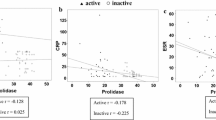Abstract
The objective of this study was to investigate any relationship between peripheral neuropathy and anti-TNF-α therapy used in ankylosing spondylitis (AS). Thirty-nine patients monitored in our clinic with a diagnosis of AS and without neuropathic symptoms were enrolled in the study. Patients were divided into two groups. The first consisted of 21 patients using biological agents for more than one year. The control group was made up of 18 patients of similar age and demographic characteristics receiving non-biological therapy. Bath Ankylosing Spondylitis Disease Activity Index (BASDAI) scores were calculated, and sedimentation rate and C-reactive protein (CRP) levels measured. Motor and sensory nerve conduction analysis for the median, tibial, and sural nerves was performed. The nerve conduction results of the biological therapy group were then compared with those of the non-biological therapy group. Thirty-nine patients with a mean age of 37.05 ± 8.1 were enrolled. Patients were divided into two groups, depending on drugs used. The first group (using anti-TNF-α) consisted of 21 patients with a mean age of 42.2 ± 8.8, and the second (the non-biological group) of 18 patients with a mean age of 35.8 ± 7.5. There was no statistically significant difference between the groups in terms of age, sex, drug use, or duration of disease (p = 0.052, p = 0.55, p = 0.33, and p = 0.72, respectively). Sedimentation rate, CRP, and BASDAI scores were statistically significantly higher in the second group (p = 0.04, p = 0.03, and p = 0.009, respectively). No statistically significant difference was determined in any parameters at nerve conduction analysis between the two groups (p > 0.05). There was a positive correlation between sedimentation rate and median sensory conduction velocity (p = 0.02, r = 0.48) and tibial conduction velocity (p = 0.07, r = 0.43). A negative correlation was determined between duration of disease and median distal motor latency (p = 0.22, r = −0.37) and between length of drug use and median sensory conduction velocity (p = 0.02, r = −0.38). There was no significant correlation between other clinical and demographic data and nerve conduction parameters. No effect on nerve conduction of biological agents in AS patients without neurological symptoms was determined. Clinicians should be alert for signs and symptoms, suggesting neuropathy in patients given anti-TNF-α.
Similar content being viewed by others
References
Apostolaki M, Armaka M, Victoratos P et al (2010) Cellular mechanisms of TNF function in models of inflammation and autoimmunity. Curr Dir Autoimmun 11:1–26
Manuel Ramos C, Roberto-Perez A, Candido Diaz L et al (2010) Autoimmune diseases induced by biological agents; A double-edged sword? Autoimmun Rev 9:188–193
Stubgen JB (2008) Tumor Necrosis Factor-α antagonists and neuropathy. Muscle Nerve 37:281–292
Kokona C, Athanasia M (2006) Anti-TNF-a Antibody Therapies in Autoimmune Diseases. Curr Top Med Chem 6:14–1707
Ko JM, Gottlieb AB, Kerbleski JF (2009) Induction and exacerbation of psoriasis with TNF-α blockade therapy: a review and analysis of 127 cases. J Dermatolog Treat 20(2):100–108
Mohan N, Edwards ET, Cupps TR et al (2001) Demyelination occurring during anti-tumornecrosis factor—therapy for inflammatory arthritides. Arthritis Rheum 44:2862–2869
Ramos-Casals M, Brito-Zeron P, Munoz S et al (2007) Autoimmune diseases induced by TNF targeted therapies: analysis of 233 cases. Medicine 86:242–251
Robinson WH, Genovese MC, Moreland LW (2001) Demyelinating and neurologic events reported in association with tumor necrosis factor—antagonism. Arthritis Rheum 44:1977–1983
Singer OC, Otto B, H Steinmetz et al (2004) Acute neuropathy with multiple conduction blocks after TNF-α monoclonal antibody therapy. Neurology 63:1754
Hartung H-P (1993) Immune-mediated demyelination. Ann Neurol 33:563–567
Zhu J, Mix E, Link H (1998) Cytokine production and the pathogenesis of experimental autoimmune neuritis and Guillain–Barre′ syndrome. J Neuroimmunol 84:40–52
Sharief MK, Ingram DA, Swash M (1997) Circulating tumor necrosis factor-α correlates with electrodiagnostic abnormalities in Guillain–Barre′ syndrome. Ann Neurol 42:68–73
Hartung HP, Jung S, Stoll G et al (1992) The role of inflammatory mediators in demyelinating disorders of the CNS and PNS. J Neuroimmunol 40:10–197
Said G, Hontebeyrie-Joskowicz M (1992) Nerve lesions induced by macrophage activation. Res Immunol 143:589–599
Kotyla PJ, Sliwinska-Kotyla B, Kucharz EJ (2007) Treatment with infliximab may contribute to the development of peripheral neuropathy among the patients with rheumatoid arthritis. Clin Rheumatol 26:1595–1596
Gündüz OH, Kiralp MZ, Ozçakar L et al (2010) Nerve conduction studies in patients with ankylosing spondylitis. J Natl Med Assoc 102(3):243–246
Lozeron P, Denier C, Lacroix C et al (2009) Long-term course of demyelinating neuropathies occurring during tumor necrosis factor-alpha-blocker therapy. Arch Neurol 66(4):490–497
Richette P, Dieude P, Damiano J et al (2004) Sensory neuropathy revealing necrotizing vasculitis during infliximab therapy for rheumatoid arthritis. J Rheumatol 31:81–2079
Tsang RS, Valdivieso-Garcia A (2003) Pathogenesis of Guillain–Barre′ syndrome. Expert Rev Anti Infect Ther 1:597–608
Richez C, Blanco P, Lagueny A et al (2005) Neuropathy resembling CIDP in patients receiving tumornecrosis factor-α blockers. Neurology 64:1468–1470
Conflict of interest
None.
Author information
Authors and Affiliations
Corresponding author
Rights and permissions
About this article
Cite this article
Capkin, E., Karkucak, M., Kose, M.M. et al. Investigation of effects of two-different treatment modalities on nerve conduction in patients with ankylosing spondylitis. Rheumatol Int 32, 431–434 (2012). https://doi.org/10.1007/s00296-010-1677-x
Received:
Accepted:
Published:
Issue Date:
DOI: https://doi.org/10.1007/s00296-010-1677-x




